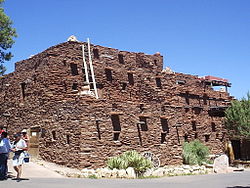Hopi House
|
Mary Jane Colter Buildings (Hopi House, The Lookout, Hermit's Rest, Phantom Ranch, the Desert View Watchtower, Bright Angel Lodge, and two employee dorms)
|
|
 |
|
| Location | Grand Canyon National Park, Arizona |
|---|---|
| Coordinates | 36°3′28.5″N 112°8′12.23″W / 36.057917°N 112.1367306°WCoordinates: 36°3′28.5″N 112°8′12.23″W / 36.057917°N 112.1367306°W |
| Built | 1904 |
| Architect | Mary Colter |
| NRHP Reference # | 87001436 |
| Significant dates | |
| Added to NRHP | May 28, 1987 |
| Designated NHLD | May 28, 1987 |
Hopi House is located on the South Rim of the Grand Canyon, within Grand Canyon National Park in the U.S. state of Arizona. Built in 1904 as concessioner facilities at the South Rim were being developed, it is the first of eight projects at the Grand Canyon that were designed by architect Mary Colter, along with Bright Angel Lodge, Hermit's Rest, Lookout Studio, Phantom Ranch, Desert View Watchtower, Colter Hall and Victor Hall, (the latter two being employee dormitories). Hopi House was built by the Fred Harvey Company as a market for Native American crafts, made by artisans on the site. The Hopi, as the historic inhabitants of the area, were chosen as the featured artisans, and the building was designed to closely resemble a traditional Hopi pueblo. Hopi House opened on January 1, 1905, two weeks before the El Tovar Hotel, located just to the west, was opened.
Mary Colter had worked on a number of projects for the Fred Harvey Company, principally as an architect and interior designer. She was particularly successful in a similar project, the Indian Building at the Fred Harvey Company's Alvarado Hotel (now demolished) in Albuquerque, New Mexico. Colter planned Hopi House as a sort of living museum, in which Hopi Indians could live while making and selling traditional crafts. The structure was based on Colter's interpretation of the Hopi dwelling at Oraibi, Arizona. The ethnohistorically-correct structure was at the time of its construction the first introduction for many park visitors to the architecture and life of the native peoples of Arizona, New Mexico, Utah and Colorado. A variety of interior spaces provide museum, sales and demonstration space.
...
Wikipedia


